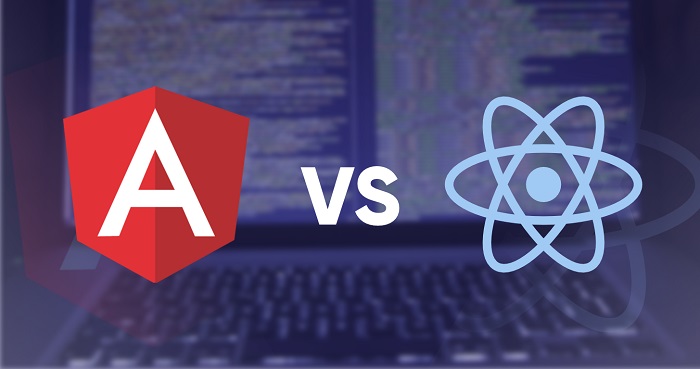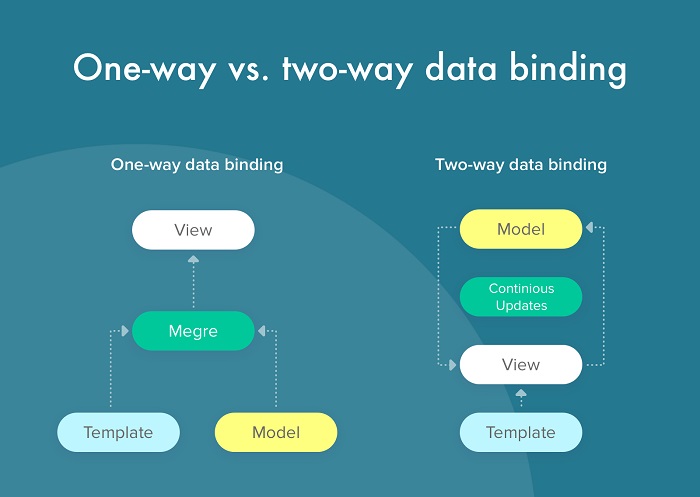You may wonder what the best choice for web development is: Angular vs React.js? In this article, we’ll discuss their tech stack, the difference between these two technologies, and the best choice to reduce development time. Let’s get started.
Quick Overview of Angular and React.js
Let’s discover what is hidden behind Angular and React.js names.

Angular
To make things clear, we’re talking about Angular 2, and AngularJS will not be mentioned since AngularJS is a slightly different and old framework.
Angular 2 is an open-source framework made with TypeScript and used to develop web apps, hybrid apps, or single-page apps.
Famous projects built using Angular
1. City Toronto
2. Indiegogo
3. USPS Tracking
4. Telegram Web
React.js
React.js is a front-end JavaScript library made by Facebook. The main purpose of React.js is to build UI using a declarative programming style. Moreover, developers use React.js to create mobile apps, web apps, and native-rendered apps.
React is an opensource library so anyone can download it absolutely for free and adjust it to fit their needs.
Here are some projects built using React.js:
# Codeacademy
# Twitter Mobile
# WordPress.com
# Airbnb
React.js vs. Angular
Now let’s compare Angular and React.js according to several criteria.
Performance
Even though both Angular and React.js are very suitable for web development, there is one huge difference between them. While React.js uses the virtual Document Object Model, Angular utilizes real Document Object Model.
What is the essence of the difference? Let’s assume that you want to change any data in the user profile, for example, the city of residence. In such a scenario, the usual DOM completely changes the entire structure of HTML tables until it reaches the data in which the city of residence is registered. At this time, the virtual DOM changes only the information we need without affecting anything else. This greatly speeds up data updates, and performance does not depend on the size of the application.

Also, the real DOM slows down the application very much when it starts working with a huge number of data requests.
Data Binding
In this aspect, React.js and Angular are quite different. React.js uses one-way data binding while Angular relies on two-way.
Two-way data binding is that changes to the data affect the presentation of the data and vice versa, changes in the presentation of the data affect the data itself.
In turn, one-way data binding greatly simplifies debugging and building the application due to the overall stability of the code.

Component Architecture
The difference here lies in the process of working with these tools. When working with React, you may need to integrate additional tools that will simplify the further development process, such as Redux, Webpack, and others. Also, React is easier to understand and can be embedded in a project, which, for example, is made in Angular.
Angular, in turn, is a full-fledged framework with many useful tools already built into it, for example, RxJS, Angular Universal, etc.
Size
The smaller the file size, the faster the download speed will be. In the image below, you can see that the Angular bundle size is noticeably larger than React.js, which makes React.js faster in loading.

Backward Compatibility
In this aspect, React.js and Angular are very different from each other, and the whole reason is that React.js is a library, and Angular is a framework. If you want to jump from, say, Angular 2.0 to Angular 7.0, you can’t do it with the flick of your fingers. You will need to install any missing updates between these versions and install everything in incremental order.
React.js has excellent backward compatibility. Nothing limits you in adding different versions of libraries to your application since you can supplement and update them at any time.
Scalability
Since many useful tools are already built into Angular, it is great for scaling applications with new functionality right out of the box.
React.js relies on the constant integration of additional tools and the situation remains the same when it comes to scaling an application.
However, using React.js it is quite possible to build a large and complex application. This is an example of WhatsApp, Instagram, etc. These are large and complex applications that are fully built with React.js.
Popularity Comparison
Stack Overflow conducted a survey among developers to find out which is more popular React.js or Angular. The numbers turned out to be quite interesting: more than 74 percent of developers enjoy working with React.js, while the percentage of support for Angular is noticeably lower at more than 57 percent.

However, let’s see the situation on other platforms. In the image below, you can see the stats for Angular 2 and React on GitHub, and the situation is not much different from the previous example on Stack Overflow: React.js is ahead of Angular in many ways.
Also, for the sake of completeness, let’s take a look at the research on stateofjs.com. The site polled more than 21 thousand respondents, and the following figures became the survey results:
# More than 71 percent of developers have used React.js before and say they will use it in future work.
# More than 35 percent of developers have used Angular before and say they will not use it in future work.
More accurate information about the study is presented in the image below.

Why Choose React.js or Angular
Both React.js and Angular are great tools for web development, and each one has its own strengths and weaknesses.
On React.js side, we have outstanding performance, small package size, and good backward compatibility. But at the same time, you need to integrate additional tools that are absent in the package, which affects backward compatibility and overall development process.
On the Angular side, we have great scalability and a wide range of built-in tools to make the development process smoother and more comfortable. But ve advised of slow performance due to real DOM that can impact overall app performance.
Anyway, things may be slightly blurry on the paper, but when it comes to the development process, if you hire Angular.js developers who know Angular like the back of their hands, they can show you what Angular is really capable of. Same thing with React.js.




